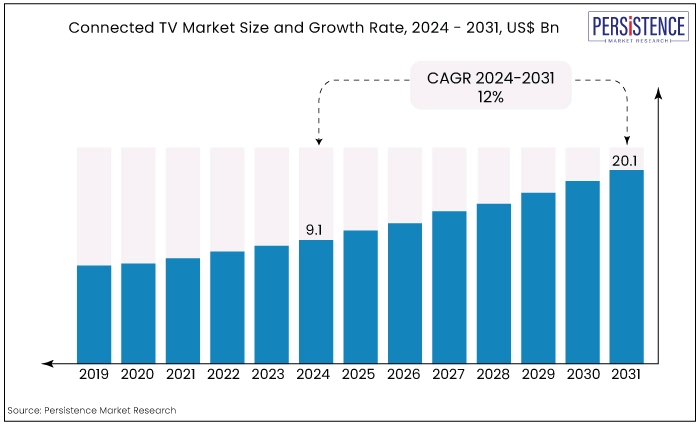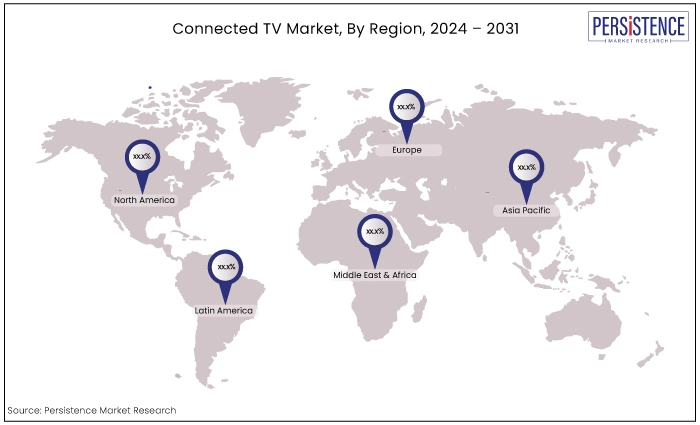Industry: Semiconductor Electronics
Published Date: July-2024
Format: PPT*, PDF, EXCEL
Delivery Timelines: Contact Sales
Number of Pages: 175
Report ID: PMRREP34684
The global connected TV market is expected to increase from US$9.1 Bn in 2024 to US$20.1 Bn by the end of 2031. The market is projected to expand a CAGR of 12% during the forecast period from 2024 to 2031.
Key Highlights of the Market
|
Attributes |
Key Insights |
|
Connected TV Market Size (2024E) |
US$9.1 Bn |
|
Projected Market Value (2031F) |
US$20.1 Bn |
|
For Growth Rate (CAGR 2024 to 2031) |
12% |
|
Historical Market Growth Rate (CAGR 2019 to 2023) |
11% |
Connected TVs, also known as Smart TVs, are television sets equipped with internet connectivity and integrated with online content streaming services, apps, and interactive features. They allow users to access a wide range of digital content beyond traditional broadcast channels, including streaming platforms like Netflix, Hulu, Amazon Prime Video, and YouTube.
Connected TVs are increasingly being integrated with smart home ecosystems, allowing seamless control through voice assistants like Amazon Alexa, Google Assistant, and Apple Siri. This integration enhances the user experience by providing centralized control over various smart home devices
The proliferation of over-the-top streaming services is a key catalyst. Consumers increasingly prefer on-demand access to a wide range of content, including movies, TV shows, live sports, and original programming, which CTVs facilitate through seamless integration with platforms.
These platforms include Netflix, Amazon Prime Video, Disney+, and Hulu. This shift from traditional broadcast television to personalized streaming experiences is fueling the adoption of Smart TVs and other connected devices.
Another key driving factor for market growth is the widespread availability of high-speed internet and broadband connectivity. As internet infrastructure improves globally, more households can support the bandwidth-intensive requirements of streaming HD and 4K content on CTVs without buffering or quality degradation.
The accessibility democratizes access to premium content, making CTVs attractive alternatives to traditional cable and satellite TV services.
Features such as 4K Ultra HD resolution, High Dynamic Range (HDR), Dolby Atmos sound, and intuitive smart TV platforms provide consumers with immersive viewing experiences and ease of navigation through content libraries and apps.
These innovations are not only meeting but also exceeding consumer expectations for home entertainment, driving continued adoption and market expansion in the CTV segment
The connected TV market continued to gain momentum during the historical period as smart TVs became increasingly prevalent worldwide. The adoption of smart TVs accelerated, buoyed by their integrated internet connectivity and support for a wide range of streaming services.
Companies focused on enhancing user interfaces, content libraries, and connectivity options to attract tech-savvy consumers seeking seamless digital entertainment experiences. The market expanded at a CAGR of 11% during the historical period. The market is poised for sustained growth driven by ongoing technological innovation, expanding content libraries, and the global shift towards digital entertainment.
Emerging market trends such as personalized content recommendations, integration with smart home ecosystems, and the convergence of TV with other digital devices are expected to shape the market's evolution in the coming years. The market for connected TV is estimated to capture a CAGR of 12% during the forecast period.

Increasing Consumer Viewership for Movies and TV Series
This is a significant factor fueling the growth of the connected TV market. This market trend is driven by several key factors. Connected TVs provide unparalleled convenience for consumers to access a vast array of movies and TV series directly from their living rooms.
With integrated internet connectivity and support for streaming services, viewers can easily browse, select, and watch content on-demand without the need for traditional broadcast schedules or physical media.
Streaming platforms available on Connected TVs offer a diverse range of genres and content types to cater to varying consumer preferences. Whether it is action, drama, comedy, sci-fi, documentaries, or international films, viewers have access to an extensive library of titles at their fingertips.
This breadth of content ensures that there is something for every viewer, enhancing overall engagement and satisfaction.
Advanced algorithms and machine learning capabilities integrated into Connected TVs enable personalized content recommendations. These systems analyze viewer behavior, viewing history, and preferences to suggest movies and TV series that are likely to resonate with individual tastes.
By curating personalized content feeds, connected TVs enhance user satisfaction and encourage prolonged viewing sessions.
Concerns about Data Breaches and Unauthorized Access
Data breaches involving connected devices, including smart TVs, can lead to the unauthorized access of personal information such as viewing habits, login credentials, and even sensitive financial data stored on connected platforms. These breaches erode consumer trust in the security of CTV devices and the platforms they interact with.
Consumers may hesitate to adopt or fully utilize CTVs if they perceive them as vulnerable to hacking or data theft. Regulatory frameworks, such as GDPR in Europe and similar data protection laws worldwide, impose strict requirements on companies regarding the collection, storage, and processing of personal data.
CTV manufacturers and content providers must comply with these regulations to avoid fines and legal repercussions. Concerns about data breaches heighten scrutiny from regulatory bodies, leading to strict compliance standards and potentially increased operational costs for businesses.
Data security concerns can stifle innovation within the CTV market. Manufacturers and developers may prioritize implementing robust security measures over introducing new features or enhancing user experiences. This cautious approach can slow down the pace of innovation and limit the adoption of advanced technologies that could otherwise enhance CTV functionality.
Content Fragmentation
One of the primary restraints hindering the connected TV market is content fragmentation. As the market has expanded, numerous streaming platforms and content providers have emerged, each offering exclusive content libraries. This fragmentation leads to a fractured user experience where consumers may need to subscribe to multiple services to access their desired content fully.
Content fragmentation also poses challenges for content creators and distributors. They must navigate complex licensing agreements and negotiate with multiple platforms to reach a broad audience. This complexity can lead to delays in content availability across platforms, inconsistent user interfaces, and challenges in maintaining a cohesive brand identity across different streaming services.
The inability to access all desired content through a single platform may lead to dissatisfaction and a reluctance to fully transition away from traditional cable or satellite TV services for consumers. This issue is exacerbated in regions with diverse linguistic and cultural preferences, where local content may be scattered across multiple platforms or not available at all.
Such fragmentation not only complicates the consumer experience but also raises subscription costs, potentially deterring consumers from fully embracing the Connected TV ecosystem.
Expansion of Interactive and Immersive Experiences
There is a substantial opportunity for industry participants to expand offerings that enhance the overall viewing experience as consumer expectations for personalized and interactive content grow. Technologies such as AR and VR hold immense potential in transforming how users interact with content on connected TVs.
AR can overlay digital information, graphics, and animations onto the real-world environment seen through the TV screen. For example, sports broadcasts could use AR to display real-time player statistics or replays overlaid onto the live game feed, providing viewers with enriched insights and engagement.
VR technology can create fully immersive experiences where users feel as if they are part of the content. While primarily associated with headsets, advancements are making VR accessible through Connected TVs, allowing users to experience virtual environments and interactive narratives from their living rooms.
Leveraging data analytics, Connected TVs can facilitate seamless integration with e-commerce platforms. Viewers could purchase products featured in TV shows or advertisements directly through their TVs, creating new revenue streams through affiliate marketing or direct sales partnerships.
The 30 to 50-Inch Connected TV Market Leads in Consumer Appeal and Market Dominance
The market for 30 to 50-inch TVs commanded a significant market share and is projected to expand significantly. This segment occupies a sweet spot in the market, appealing to a wide range of consumers looking for a blend of affordability and quality viewing experience suitable for living rooms or medium-sized spaces.
The increasing availability of high-definition streaming services, offering extensive content libraries, further enhances the attractiveness of this size range for viewers seeking immersive entertainment without compromising on budget-conscious choices.
TVs within the 30 to 50-inch range are versatile and well-suited for various room sizes, making them popular choices for both smaller living spaces like apartments and larger family rooms. They strike a balance between screen size and space requirements, catering to consumers looking for a TV that fits comfortably in their environment without overwhelming the space.
Asia Pacific to Witness a Surge in the Market
The region has seen widespread adoption of smart devices, including smartphones, tablets, and smart TVs. Smart TVs, in particular, are gaining popularity due to their integrated internet connectivity and support for streaming services.
Asia Pacific has witnessed a surge in OTT platforms like Netflix, Amazon Prime Video, and local players, offering a vast library of content that drives CTV adoption. China, and India are the primary growth engines within Asia Pacific.
In the dynamic landscape of Asia Pacific, there has been a notable embrace of smart technology across devices like smartphones, tablets, and notably, smart TVs. The surge in popularity of smart TVs can be attributed to their seamless integration of internet connectivity and robust support for streaming services.

In the fast-evolving connected TV market, companies are strategically positioned to cater to the growing demand for a diverse range of interactive devices seamlessly integrated with television displays.
From game consoles to digital media players, hotel TV systems, smartphones, Blu-ray players, and set-top boxes, the focus is on enhancing connectivity and user experience.
Key players in the industry are not only investing significantly in research and development to drive technological advancements but also expanding their product offerings to diversify revenue streams.
Moreover, mergers and acquisitions play a crucial role in consolidating market presence and fostering innovation across the sector.
April 2023
Xiaomi India unveiled its latest lineup of 4K smart TVs in April 2023, introducing the X Pro series with three distinct variants: 43-inch, 50-inch, and 55-inch models. These new TVs promise enhanced color reproduction, contrast, saturation, and brightness, significantly expanding the color gamut when compared to Xiaomi's previous X series offerings. This launch underscores Xiaomi's commitment to delivering advanced visual experiences and catering to the evolving demands of the connected TV market.
May 2023
Foxxum, a prominent player in the connected TV solutions sector, bolstered its app offerings with an updated version of the popular kicker app from Germany's renowned sports media brand on May 9, 2023. This revamped kicker app delivers a wealth of content, including breaking transfer news and comprehensive coverage spanning football, ice hockey, motorsports, handball, and basketball. This move underscores Foxxum's commitment to enhancing the digital sports viewing experience through connected TVs.
|
Attributes |
Details |
|
Forecast Period |
2024 to 2031 |
|
Historical Data Available for |
2019 to 2023 |
|
Market Analysis |
US$ Billion for Value |
|
Key Regions Covered |
|
|
Key Countries Covered |
|
|
Key Market Segments Covered |
|
|
Key Companies Profiled |
|
|
Report Coverage |
|
|
Customization & Pricing |
Available upon request |
By Screen Type
By Usage
By Screen Size
By Platform Type
By End Use
By Distribution Channel
By Price
By Resolution Type
By Display Type
By Region
To know more about delivery timeline for this report Contact Sales

The increasing number of connected devices is a key driver for market growth.
The global market is expected to increase from US$9.1 Bn in 2024 to US$20.1 Bn by the end of 2031.
Some of the leading market players operating in the market are Samsung Electronics Co., Ltd., Sansui Electric Co., Ltd., and Furrion, LLC.
Expansion of interactive and immersive experiences presents a key opportunity for the market players.
The market for 30 to 50-inch TVs is expected to expand significantly.